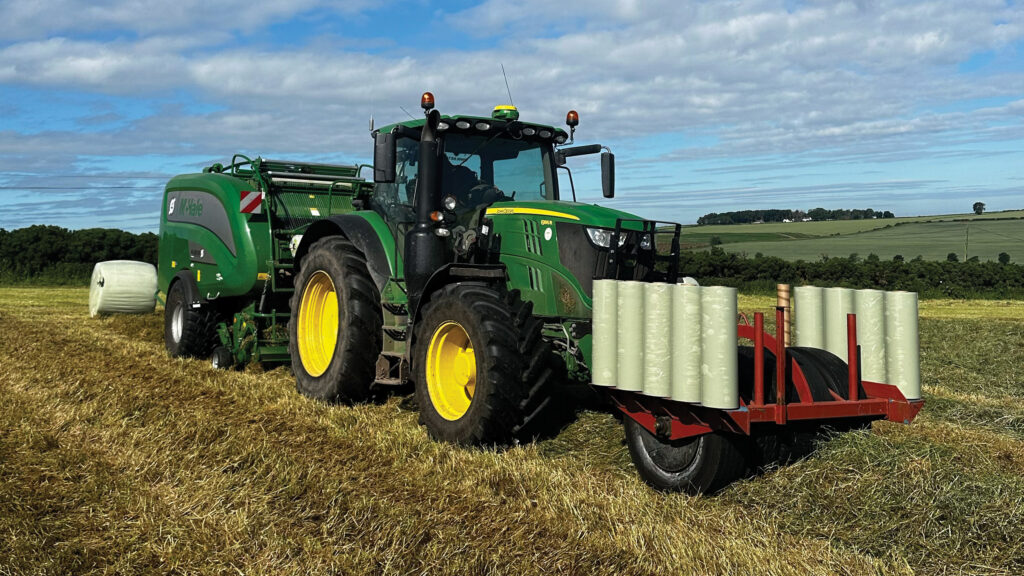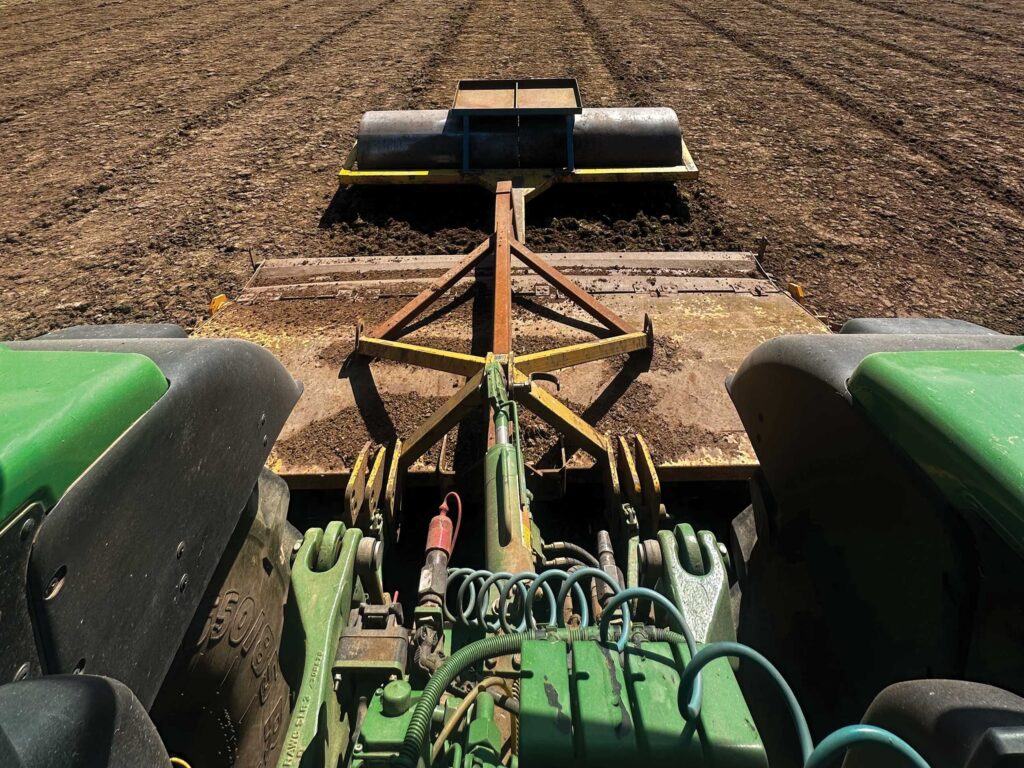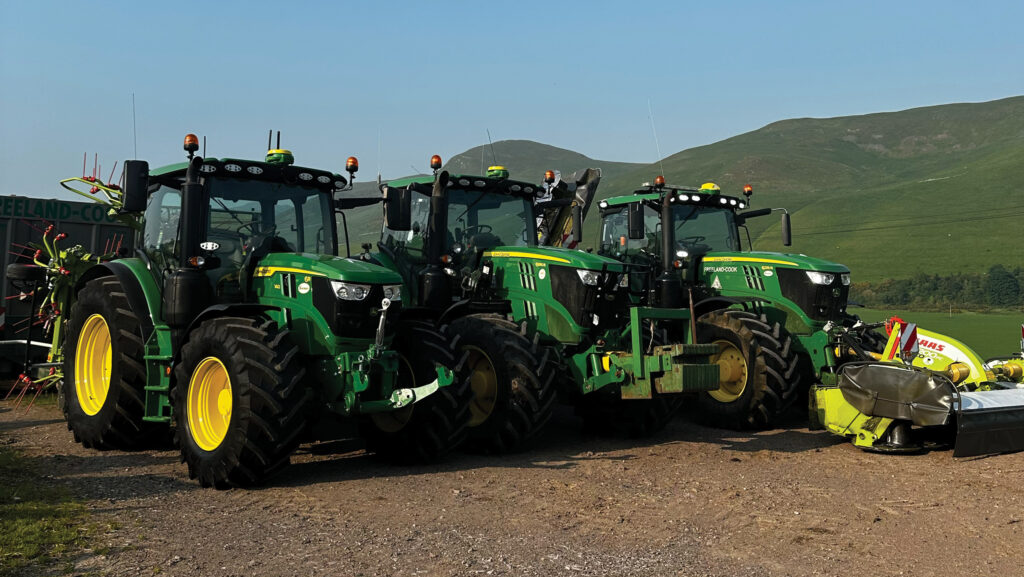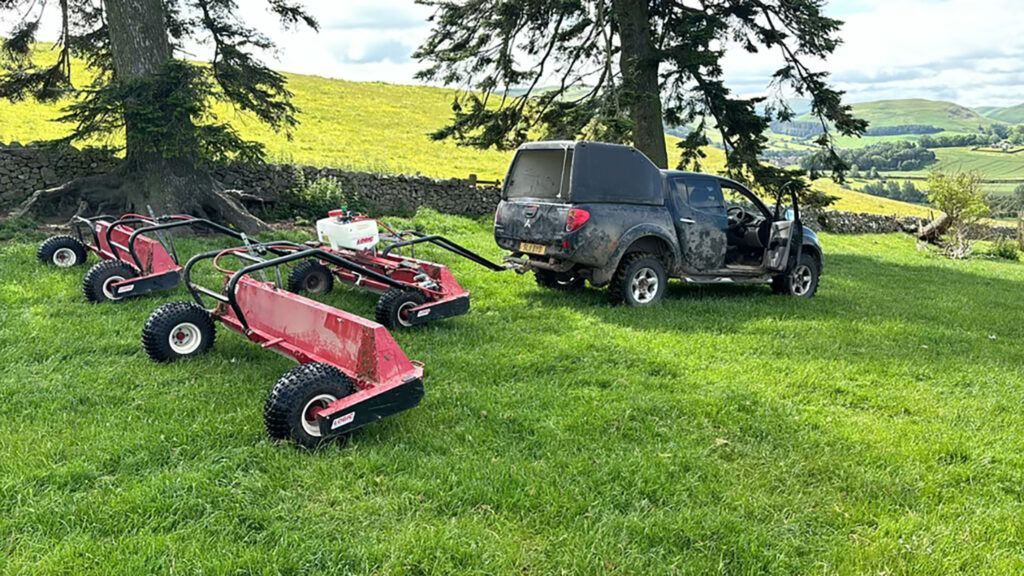Contractor Comment: Warranty dilemmas and pricey pickups
 © MAG/Oliver Mark
© MAG/Oliver Mark High lamb prices, new kit and plenty of silage in the stack have lifted spirits at Daniel Freeland-Cook’s family-run farming and contracting business, following a dismal winter that hampered lambing and froze grass crops in a bleak time warp.
However, the weather did improve for the most critical 17 days in the Cliftoncote Farm calendar, with its first block of 1,400 ewes lambing with Swiss watch-like precision in late February.
These are contract managed on a profit-share agreement and all are brought under cover for the event, meaning the staff must endure long days – and nights.
See also: Contractor Comment: Lots of plans but not enough staff
Business facts: Cliftoncote Farm, Yetholm, Scottish Borders
- Farm 2,400ha in four contract farming agreements across seven sites
- Cropping Mainly grass and green crops such as kale and fodder beet
- Stock 5,000 ewes, 1,600 ewe hogs and up to 8,000 lambs; 120-head Hereford and Saler suckler herd
- Main contracting services Grass reseeding and harvesting, green crop sowing, forestry track construction and maintenance, other groundworks, and livestock management
- Staff Daniel; brother Allistair and his wife, Clair; niece Emma; nephew Thomas, a full-time shepherd; seasonal tractor drivers and lambing support; plus Daniel’s parents to help with admin
“Producing early season lambs is an expensive way of doing things,” says Daniel. “It’s non-stop for the staff and quad bikes are constantly on the go.”
The sheer numbers mean ewes and lambs are funnelled through the system quickly over the course of a couple of weeks, getting just a day of care in one of the 220 individual pens.
As a result, the ATVs are constantly shuttling stock back out to pasture, and the weather can really make or break it.
“We can’t stop the ewes lambing, but we were lucky this year as it coincided with a rare dry spell,” he says. “Sadly, our second batch of 3,500 ewes, which lamb outside over a six-week period, didn’t have it so good.”
Running the snacker on slippery hillsides was treacherous, and food wastage was an issue – even though they only creep feed the twins.
“Fortunately, we’ve got a great team of lads,” says Daniel. “They took a caning over the cold and wet – and my niece’s catching dog broke its leg in the first week – but they pulled through.
“It was a good reminder that it pays to look after the staff – whether its investing in good waterproofs or feeding them well.”
But, with lamb prices at £8/kg for an unusually sustained five-week period, the effort has paid off.
“Selling fat lambs for £170-£190 a head, with an artic load going out every 10 days, has made it all worthwhile,” says Daniel. “Trade has been great lately, but that’s not always the case.”
Grass trials prove fruitful
For the past four years, the business has set up agreements with a local arable farmer that gives free use of his land from the end of August, once cereals crops have been harvested, through to pea drilling in late May.
The aim is to fully exploit that window to maximise forage returns, both through grazing and then silaging the crop.
Last year, Daniel managed to drill 30ha of fast-growing Italian ryegrass as soon as the combine departed, and at half rate to keep his establishment costs down.
This was grazed through the autumn and winter, then closed off and given a dose of liquid fertiliser. A cut of silage followed in May – immediately before pea drilling began.
“We got 10t/ha of silage off that ground – 20 bales/ha – despite the cold weather slowing early-season growth.”
In all, he reckons he gained £3,000-worth of grazing this year and 355t of silage valued at nearly £18,000, based on £50/t (£25/bale).
However, it is by no means cost-free. Expenses extended to £3,900 on seed and another £3,300 in fertiliser – totalling £120/ha, plus the cost of drilling, mowing, raking and baling. It also required a big transport effort, with nine trailers summoned for the 20-mile haul back to base.
Some of the bales have already been sold to cover the cost of the wrap. Others will go to the farms on which he contract-rears stock, while the rest – some 600 – have bolstered his own stash.
“That’s one third of our winter feed already in the stack. As much as anything, it’s an insurance policy against an awful second cut,” he says.
Drilling options
That crop – and the rest of the grass and green fodder – was established with a 6m Opico Grass Master, which replaced a 3m Moore Unidrill a couple of years ago.
Quicker and more versatile it might be, but favourable slot seeding conditions both this spring and last have left him rueing the decision to change.
“The last two years have been damp and perfect for a slot seeder. But, as it was, we were finding the ground too hard for the discs to penetrate. It’s sod’s law, I suppose.”

Seed-bed prep with the Dyna-Drive and flat roll combination © MAG/Oliver Mark
Still, those favourable conditions have made for good seed-beds, formed this year with a Bomford Dyna-Drive – bought 25 years ago for an agreed £500, but with the bill yet to turn up – paired with a flat roller.
“I still dream about buying a Vaderstad Carrier, but the Dyna-Drive has made beautiful job of things.
“Plus, it’s only 3m wide and dead easy to pull, it only works the top three inches, and we can drag the flat roller behind to level and weatherproof the surface.”
Germination has been rapid, with the kale through in five days, but the challenge has been in keeping it growing.
“A pre-em dose of Rapsan does a great job on the weeds, but the follow-up spray of Decis Protect for flea beetle has been questionable,” says Daniel. “I’d have been better off spending that money in the pub.”
New baler finally arrives
The first of the new machines to arrive this year was a film-on-film McHale Fusion 4.
The investment stung in that it cost £15,000 more than the Fusion 3 it replaced, but it has a bigger screen for the cameras, air brakes and external rear wrapper controls. Crucially, it also has a new camless pick-up.
“We’ve pushed it hard – we’re raking a bulky 30ft crop into one swath, but we produced 1,700 bales in its first week of work without a single problem,” Daniel says.
“That’s mainly down to the improvements on the intake, which is a tremendous upgrade on what went before.”
It doesn’t necessarily translate into greater output, though, with forward speed still limited by the speed of the wrapper.
“There’s no point baling fast and then having to wait for the wrapper, as you just end up with a softer bale.”
The higher purchase price of the baler has more than offset the drop in plastic wrap costs, so his contracting rates will likely stay the same this year.
This works out at £10 for a 4.5ft, 600kg bale, of which £6 is plastic (at last year’s prices).
The rest covers the cost of the baler, knives and wrapper, but not diesel, which adds roughly 40p/bale.
“Fortunately, we’ve got a great deal with Michael Purvis at Lloyds Tractors in Kelso for the wrap,” he says.
“They’re competitive on price anyway, but the fact that they allow me to defer payments to four instalments from September onwards means I can get money in before I have to pay it out.
“It’s a godsend given last year we got through 16 pallets – about £50,000 worth.”
The one minor drawback this season has been the John Deere 6195R – not in its performance, but because it is shod with low-profile 710/60 R42 tyres.
The previous baler tractor – a Valtra – was on 650/85 R38s, and this translates into a 4in difference in drawbar height over the crop. As a result, he has had to fit a swath press on the front.
“It actually produces a better mat of grass but it’s a faff, as the press needs lifting when placing bales on the hillside and when cornering.”

The last Valtra has just left Cliftoncote Farm © MAG/Oliver Mark
Tractor changes
The second new arrival was a John Deere 6R 140, concluding a frustrating five years running Valtras.
“The decision to go with Valtra cost us dearly,” says Daniel. “The Deeres were getting too expensive and the money we saved in switching brand paid for £10k’s worth of RTK guidance, front ptos, longer warranty and more horsepower. But we were constantly battling reliability problems.
“In hindsight, we should have just paid the extra £500/month of finance for a John Deere.”
The last Valtra to leave the yard was a four-cylinder N175 on 4,000 hours, which went for roughly £45,000.
Despite the issues, Daniel says it was a pocket rocket that packed a lot of power for its size.
The new high-spec 6R AutoQuad will be fitted with an existing three-year-old Quicke loader – at least once the mounting brackets turn up. It’s been a near-three-month wait so far.
“John Deere wanted mid-teens for a loader, which we weren’t willing to pay given we’ve already got a perfectly good one and we’d forked out the best part of £130,000 on the tractor,” Daniel says.
But the jury is out on whether it needs chipping. In part, that’s because he originally wanted a 6R 150, but for the fact that it is only available with a stepless transmission.
The plan is to keep it for four or five years, as it has extended warranty built into the finance package.
However, protection for the older 6215R is proving more of a head-scratcher.
After it arrived a year ago on 1,500 hours, Daniel forked out for the firm’s GreenShield cover.
“It’s a bit Mickey Mouse in that it only covers the main components for 2,000 hours or two years – whichever comes first.
“Trouble is, we’ve clocked the hours in 13 months and it’s already up for renewal.
“That’ll cost us £7,900, which is a lot given it’s effectively an annual expense.”
So far, the warranty has covered a new fuel pump and repairs to the Command Arm joystick (£1,500), but not replacement rear mudguards (another £1,500) required due to iffy mountings.
“It begs the question as to whether the cover is really worth it,” says Daniel.
“The 215 has been a tremendous tractor that ticks all the boxes for us – it’s as good, if not better, than the far more powerful Valtra T254 [275hp] it replaced.
“The only things we miss from the Valtra are the 60kph box – it was an absolute flyer – and the size of the cab.
“We could fit five sheepdogs in it; we’d be lucky to get one in the John Deere.
“But the main reason for going back to Sherriffs for the Deeres was the backup offered by the Jedburgh branch. It has always been first class.”
New old pickup
The other machinery-based issue causing angst is the cost of pickups.
The business runs six 4x4s in all and, when the chassis on Daniel’s old Toyota snapped in half, he was forced to do some unexpected shopping.
“Six years ago I was paying £6,000 for a 10-year-old pickup on 100,000 miles.
“Two years ago that price had gone up to £10,000 for the Hilux, and the Ford Ranger I’ve just bought – also 10 years old on 100,000 miles – cost me £13,000.
“They seem to be getting more expensive and worse.”

Weed wiping is now the business of a beaten-up L200 pickup © MAG/Oliver Mark
The most useful in the fleet has proved to be an MOT-failed Mitsubishi L200 (11-reg) used to cart diesel to the digger on forestry work and, latterly, to pull a 30ft weed wiper on the hillsides.
“It’s far better than a quad – you don’t get sunburn, it’s got a radio, and there’s plenty of space to carry water and chemical on board.
“You can also chuck a dead ewe in the back if needs be.”
Alongside these are three Defenders – a 90 that refuses to give up, and two 110s.
“We keep them until they die. I only recently cleared out the graveyard of Hiluxes, Troopers and Suzukis.
“But 4x4s are an essential part of a mobile system like ours. We’re constantly on the move and hauling trailers, and they get flogged.
“Fortunately, the team at Frank Gibson, the local garage, goes above and beyond to keep them going. We wouldn’t be able to function without them.”
About the contractor
Daniel Freeland-Cook runs the contracting arm of his family’s beef and sheep business based in Yetholm in the Scottish Borders.

